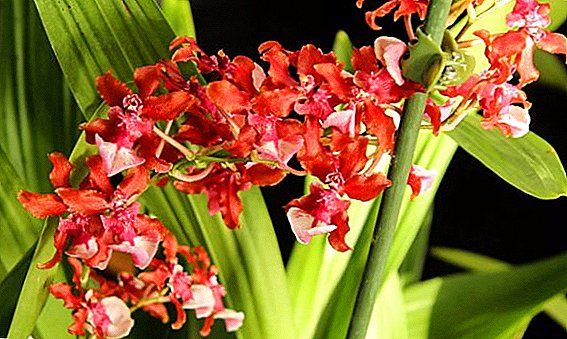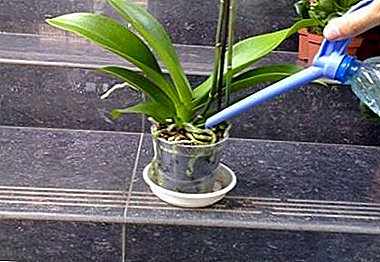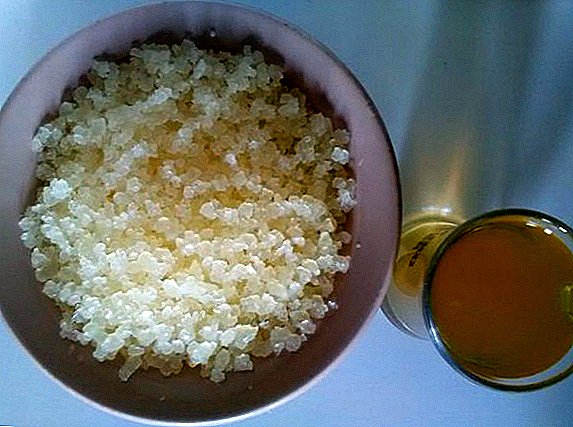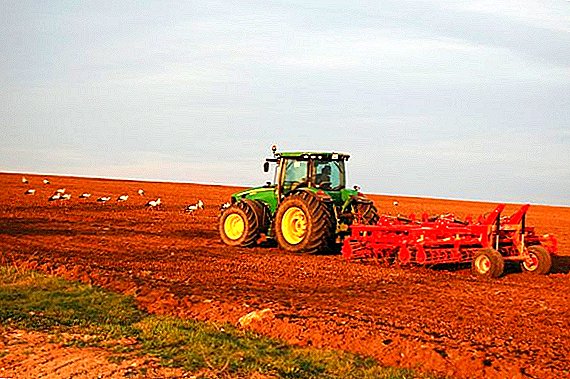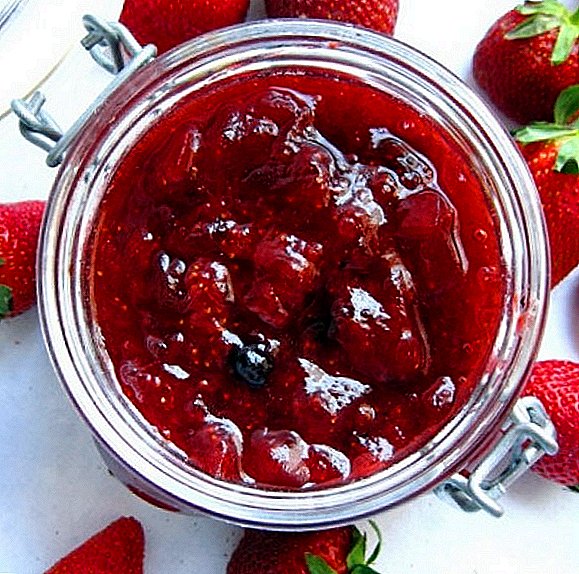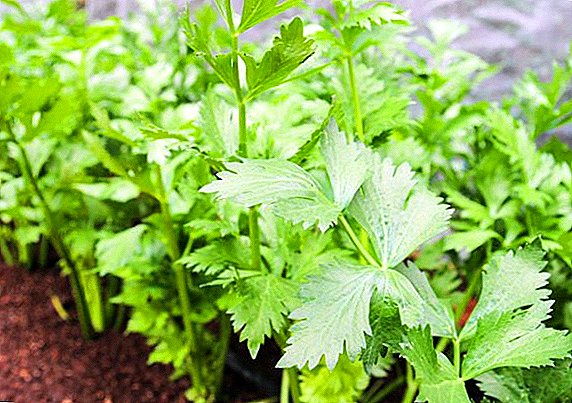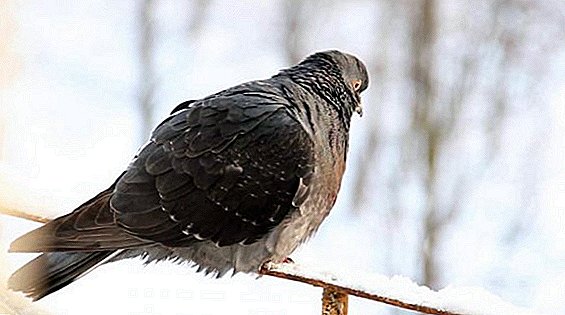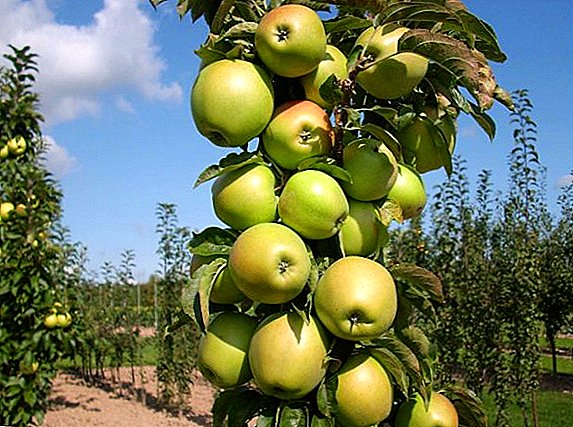 Standard trees are a real find for owners of small gardens, in which there is always not enough space.
Standard trees are a real find for owners of small gardens, in which there is always not enough space.
Kolonovidnye varieties of fruit crops can effectively use the area, at first can grow in bulk pots and at the same time generously bear fruit.
One of the promising winter varieties of apple trees with vertical crowns is the "President", the fruits of which strike not only with quantity, but also with size. How to grow an apple tree of this species, what conditions need to be created on your site for its full development, its main advantages and disadvantages will be discussed further.
Apple "President": characteristics and description of the variety
Colon-shaped apple varieties "President" in botanical descriptions, many qualify as semi-dwarf fruit trees. Their trunks barely reach two meters in height, which is convenient when harvesting. Seedlings of this variety have a very developed powerful root system, which easily adapts to any non-acidic soil, adapts well after transplanting.
Inflorescences are already forming on the second-year saplings., but professionals advise them to be removed so that the tree is strong before the start of fruiting. In the fifth year of life, "President" produces a harvest. On average, one young trunk can be removed up to 7 kilograms of large apples. In favorable conditions, with proper pruning, dressing and regular watering, a mature apple can bring more than 15 kilograms of crop.
The life span of this variety of apple trees, like of all columnar trees, is up to 50 years, but stable high yielding will last only a third of this period. The length of the “President” is not wide, its thickness at a mature age barely reaches 20 cm. The tree is winter-resistant and imparted with immunity to typical apple diseases and harmful insects.
Did you know? Trees with vertical columnar crowns were bred by chance in the 70s. One Canadian gardener somehow noticed in his garden on an old apple tree, “Macintosh,” an unusual thick and even sprout, on which there were absolutely no branches, but it was heavily weighed down by the fruits. In the spring, the stalk from this branch received a new life, since it was grafted on the stock. For several years, an amazing tree has grown out of it, which has not branched, but has abundant fruit.A brief description of the fruit of the apple-variety colonic "President" can be conveyed by several phrases: sour-sweet apples, with tender juicy flesh, taut and thin skin of yellow-green color.
The weight of one fruit ranges from 150-250 g. The beginning of ripening occurs in the last weeks of summer and lasts until mid-September. Apples have good transportability and keeping quality. Subject to the rules of preparing the harvest for winter saving, it can last until the New Year.
Many housewives process fragrant fruits for home canning, make them dried fruits or leave for fresh consumption.
Common pests of apple trees are aphids, which are spread by ants, apple moths, ticks, and May beetles.
Where will grow the apple tree: select the conditions for growing
A strong seedling with a powerful rhizome without any damage, nodules and a straight thick boom is the key to a full tree vegetation during the first decade. But for the variety "President" and the successful cultivation of it is not enough. It is important to choose the right place for future landing. In this case, special attention should be paid to the location of groundwater, lighting and physiological features of the earth. We will understand in more detail. 
Important! During the flowering period, standard apple trees are recommended to be sprayed with sugar syrup to attract bees.
Lighting for the apple tree
The "President", like other varieties of columnar apple trees, prefers a well-lit, even, protected from northern winds and drafts, a site away from cold lowlands, marshy and stony terrain. The tree will not be comfortable developing in the sun and slopes, as well as in areas where groundwater is located closer than one and a half meters from the soil surface. Look in your yard for a place where there is a lot of diffused light, no shade, snow accumulates in winter, and spring water does not stagnate.
In what soil to plant a columnar apple of the President variety
For President trees, light substrates with neutral acidity are recommended, as well as a columnar culture will take root well in black-earth soils, which are characterized by nutrients and life-giving characteristics.
To at home check the acid reaction of the earth, you need to dial a glass of water and add a small handful of top layer, sprinkle soda on top. The beginning hiss indicates the need to neutralize the substrate. The procedure is carried out using a well-known pushonok or old plaster. Material is introduced in the range of 150-300 g per square meter of garden. 
Important! Bark, needles and wood of coniferous crops cannot be used as mulch. They contribute to the oxidation of soils.
Planting technology
Planting "President" - varieties of columnar apple - can be planned for the autumn and spring time. Among biologists, it is assumed that in October only those specimens that are more than two years old are planted. Many specialists are prone to rooting of seedlings in March, because in this case the tree has enough time before the onset of cold weather to grow a strong crown and strengthen the roots. It is important throughout the warm season to provide the necessary moisture to the apple tree. Let us analyze in detail all the stages of landing.
Landing pit preparation
Before planting the apple tree "President", a number of preparatory works should be carried out. When with the choice of a sapling and a place for landing were defined, it is possible to start preparation of a hole. The first thing you need to dig a 75 cm recess with a diameter of 1 m. If the root system of the seedling is small, you can reduce the size so that the roots are not crowded.
When digging the hole, fold the first 10 spade bayonets onto a separate mound. This is a fertile layer of soil, which later will be useful for planting. It is mixed with equal parts of peat, compost and humus. In the middle of the pit they drive in a wooden peg with a pointed and burnt edge, drainage is poured around it and the prepared substrate is poured from above. 
Did you know? On a global scale, the apple production championship belongs to the People’s Republic of China. The second place was taken by the United States of America. Within Europe, Poland is the largest exporter of apples.Some gardeners make a mound to the middle of the depression, while others fall asleep to the top. This is explained by the fact that in the future an apple tree planted as a result of soil subsidence will not be in a funnel with stagnant water. After the done manipulations, the pit is covered with a plastic film, securing its edges, and left for 4 weeks. During this time, a specific microclimate is formed inside, which is necessary for the successful germination of the seedling.
Planting plantation
Having learned when to replant columnar apple trees, let's look at the main technologies. Gardeners distinguish between their two.
The first involves compaction boles in rows with a distance of 40 cm between them. At the same time, the row spacing is up to 2.5 meters.
The second way is in a square planting, when adjacent trees on all sides are located after 1 m.
Some gardeners use the third classic option, representing a 90 x 60 scheme. The miniature kolonovidnye krona "President" is well combined with other low-growing cultures and allow you to create a large garden in a small area.
Did you know? If you sow a hundred seeds from one apple tree, completely different trees will grow out of them.
Basic rules for caring for apple varieties "President"
Apple tree colony varieties "President" is not demanding in planting and care. For a good growing season, it is enough to provide the tree with a moisture regime, regular feeding, competent cutting and preparing young seedlings for the cold. Delve into the details of how to do it right.
Soil moisture and watering apple trees
In the first year of life, apple varieties "President" require much more moisture than mature trees. It is necessary to water them often in small portions. The main thing is that the earth in the near-circle wheel does not dry out and not be covered with a dense dry crust. Watch the soil: it should not dry out and turn into a swampy slime. In such conditions, the roots will either dry out or start to rot from excess moisture. Therefore, the key role is played by the measure in the number of irrigations.
It is advisable to moisten young trees up to two times a week, for three-year specimens, 30 liters of liquid are sufficient for 7 days. In large garden areas, the irrigation process is facilitated by rain and drip installations, supplying water in a constant stream in small portions. All moisturizing procedures, regardless of the method, are carried out in the evening, so that during the night the tree absorbs moisture and does not get sunburn. 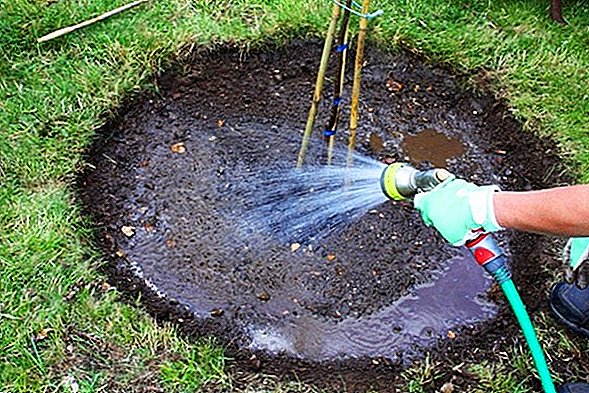
Did you know? Apples for 25 percent are made of air, because they do not drown in water.Short-term irrigation at the peak of a hot day only hurts the apple tree. Therefore, it is important to monitor not only the time of the procedure, but also the state of the substrate. After the procedure, he should get wet to a half-meter depth.
How much water to pour out under each tree depends on its age. One-year saplings will need up to 3 buckets, and five-year-olds - 5. First watering for all fruits is organized in the spring before buds begin to bloom. The second for mature apples is planned during the formation of greenfinches, the next - during their growth. Last moistening in the absence of heat is carried out 2 weeks before the harvest. And with a long dry autumn, the procedure is repeated, thus protecting the roots from freezing in winter.
Features feeding the varieties "President"
Yield of apple can be significantly increased literate systematic feeding. They are carried out throughout the entire period of tree development. Begin in the spring when shoots enter a phase of intensive growth, watering the tree trunks with an infusion of chicken manure. For this purpose, a depression of 30 cm is made in the soil, and fertilizer is poured into it. After the procedure, the hole is sealed with soil. 
Important! Nitrogen-containing substances in apple trees are needed in the spring to increase biomass. It is extremely undesirable to bring them in the autumn, since the young gains that have not got stronger will not be able to spend the winter. Such stress can destroy a miniature tree.At the beginning of the fruiting period, apple trees are prepared with mixtures of equal parts (1 tablespoon) of ammonium nitrate and nitroammofoski, 140 g of superphosphate and one and a half tablespoons of potassium chloride are added. All ingredients are thoroughly mixed, and dissolved in a bucket of water. The solution can be replaced with superphosphate and potassium sulfate dissolved in 10 l of water, taken in a proportion of 100: 10 g.
Winter-hardy qualities of fruit trees must be strengthened with mineral complex fertilizers, which are marked "autumn". The procedure is carried out in the first weeks of September. Alternatively, suitable humus.
How to prune the columnar apple
A small compact apple tree of the “President” variety needs formative pruning only in cases when the branches are developing incorrectly, are ill and interfere with each other. The vertical shape of the tree does not provide for frequent pruning, since the lateral branches on the trunk are very weak.
Pruning is important in the event of damage to the upper fruit bud, when two competing tops form on the trunk. Do not wait for their uniform development - the one that is weaker must be removed. On fruit shoots, it is recommended to pinch 2 buds each year.
Important! In the case of spring planting, the seedling is watered until the earth absorbs water.On the second-year apple trees of the "President", inflorescences begin to form. They are completely removed so that the tree is strong, it has a strong trunk and roots. The next year, up to 6 flower brushes are left, and the most viable are selected. In the process of shearing, the shoots that are either frozen or frozen have also been removed.
Protecting Apple "President" from the cold
Some summer residents are firmly convinced that winter-hardy varieties do not need shelters for the winter, and in the spring they are disappointed when they see plants damaged by frost. Such a mistake is completely unjustified. Young seedlings up to the age of five are equally sensitive to low temperatures, so they risk not overwintering without human intervention.
Most apple trees for successful pollination should have neighbors of other varieties, so it is interesting to consider the peculiarities of growing apple trees, Melba, Candynoe, Zhigulevskoe, Spartan, Medunitsa, Mantet, Welsey, Gloucester, Semerenko, Mechta, Champion, Bashkir beauty, Korichnaya striped, Berkutovsky, Currency, Northern Synapse.In the northern regions, where winters are characterized by long, severe frosts, trees are hidden in long trenches that, before the onset of cold weather, are filled with fallen leaves, sawdust and snow. In temperate climatic latitudes, it is not worthwhile to resort to such radical measures, since the roots and stems under too warm cover may dry up.
For wintering, it is enough to mulch the tree circles with a 10-centimeter layer of any mulch, with the exception of coniferous. And also wrap the root of the tree with thick cloth. The trunk must be protected with a spruce or half-meter sheet of roofing felts. This is done to protect the apple trees from hungry hares and other rodents. 
Did you know? If you put the apples in the cellar next to the potatoes, the root crop will begin to grow their eyes and grow old. Accelerated ripening threatens the fruit, due to the ethylene released.
Features breeding varieties
Nursery specialists propagate shtambovye apple trees by budding, but they confess that the method is not easy, because on the vertical trunk it is problematic to get petioles for reproduction. Based on the fact that there are practically no lateral growths on it, professional gardeners resort to heavy cutting of the trunk. This nuance contributes to the intensification of branch extensions. Up to 15 shoots appear on each uterine specimen.
At home, you can get the desired shtamb by grafting cuttings of the sort you like on an ordinary apple tree. From its crown a vertical branch densely hung with fruits will stand out.
Crown-shaped apple tree "President": advantages and disadvantages of the variety
If we compare miniature semi-dwarf apple trees of standard types with sprawling tall fellows, without much effort, you can find many beneficial differences. From the responses of gardeners and professional gardeners, the conclusion is that the apple "President" has the following qualities of the variety: 
- neat compact crown of small size, which is convenient for cultivation in small household plots, as well as during harvest;
- early and abundant fruiting, accompanied by stability for 15 years;
- decorative trees;
- endurance to low temperatures, immunity to diseases and pests;
- transportability and keeping quality of fruits;
- high taste and commodity qualities of apples;
- the undemanding nature of the tree to the soil and the conditions of cultivation, ease of care.
Important! When harvesting and preparing apples of winter varieties for storage, it is impossible to wipe off wax from the skin. It protects the fruit from the penetration of pathogens and fungal spores.Competent care for the apple orchard and its annual partial rejuvenation will prevent a decrease in yield and fruitlessness of the President’s apple trees. This variety competes with the elite selection of domestic and foreign production. To see this, it is worth a try.



